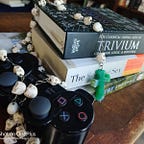making peace with grief
On my wall is a piece of white, opalescent fabric. A needle hangs from it by a black thread.
In the fabric are nine-hundred and sixty neat, black stitches. They’re organized into eighty sets of twelve. Three hundred and thirty-three of the stitches have been crossed out with another stitch. Six hundred and twenty-seven more stitches remain, uncrossed.
In time, I hope to cross out them all.
My partner affectionately calls this my “death calendar.”
You may have picked up by now what this fabric hanging on my wall means: it’s a count down to the end of my life. Each stitch represents a month of life I’m expected to live, every crossed stitch represents a month I’ve already lived, and each stitch yet to be crossed is a month I’ve yet to see. There are 80 blocks of 12 stitches: eighty full years. If I live past 80, I’ll simply add more stitches. But until then, I expect myself to only get this far. I leave no room for “what if?” This is memento mori — I will die.
On the first of every month I cross out another stitch. I take the needle that hangs off the fabric and think about the previous month, smiling. It’s a soothing ritual. I like to run my hand over the crossed stitches.
In 2019, I nearly died on a hospital table. I understand now why some describe near-death as a light at the end of a tunnel, or a door in a dark room. It’s the best we can do when trying to articulate how it felt. It wasn’t a frightening experience, not once I was faced with what I can best describe as the sense I was near an exit and the sense I’d been invited through. I declined the invitation.
I still don’t know why I didn’t accept.
Then my daughter was born. The physician scrambled to sew me shut so I’d stop bleeding. The worry was I’d go into shock and take the mysterious exit if given a second chance. There was no time to numb the area. I felt every stitch as the thread the physician used tugged at my raw, open flesh — she went fast and I started cursing and shouting. But the worst was over. Skilled needlework saved my life, though I can still feel the scars.
I learn a lot about house guests when I explain to them the purpose of my odd looking wall-décor. The reaction has never been anything like “oh, that’s nice.” No. It’s like they’ve swallowed something bitter and choke on their words. They see my project as sobering, taboo, intense. Even if they admire the concept, the subject of conversation quickly changes.
The experience left me traumatized and somewhat a mystic. The tiny black stitches on my wall make me happy, they help me focus, they bring me peace. Death feels sacred. My life, like any good story, has chapters and an ending. At least it’s helpful to frame it that way.
Sometimes I miss that door.
I died — maybe not in the medical sense of the word (or if I did, no one told me) — but whoever I was before is gone now. It was difficult and scary. It happened suddenly. Who I was before wasn’t a bad person and was on her way to leading an interesting and happy life. She’s never going to live that life.
I grieve for her but I accept she’s gone. I’m saddled with her past but I don’t experience her pain. Both her dreams and her sadness are done. Things have changed.
My sister was one of my first visitors after the baby was born. She looked like she’d just rolled out of bed. I asked her how her day had gone, since I wasn’t interested in talking about my last 48hrs. My partner held our daughter and my crotch was numb thanks to a generous share of drugs and ice. The room was quiet.
Bewildered, not quite awake, my sister said “I got my asshole waxed. It felt weird. But I feel so fresh.”
Man, it hurt to laugh. But it was the first laugh I’d made over the last two days and it was worth it. The first of many laughs that fill my new life.
Take note: death didn’t magic away my problems. This isn’t a story where the protagonist goes on to become a fully enlightened buddha or a born-again Christian. I still struggle with economic precarity, day-to-day decision making, and my mental health. The death, disease, and isolation brought on by the covid-19 pandemic affect me like they do everyone else. I’ve lost people to distance and death since 2019.
I struggle. I fail. I’m tired.
But at the same time I find these stitches on my wall keep me humble and hold me still. Grief is a part of me and, I think, a part of everyone who has ever experienced great loss and change. What my brush with death taught me is how to make peace with my grief.
Death and grief are part of the larger fabric of my life. Death is a part of my life, whether I like it or not, and I love my life: all of it.
